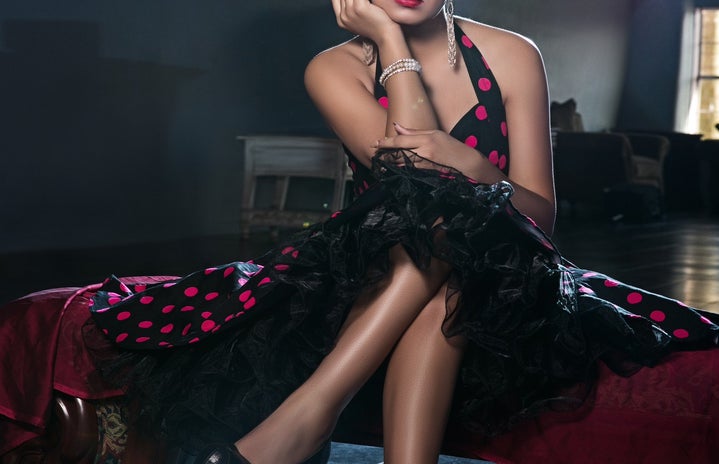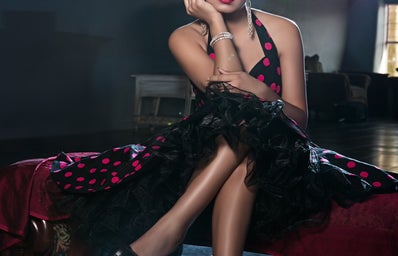Burlesque. What does this word mean to you? For many, Burlesque invokes images of scantily clad women dancing seductively while performing a striptease for a primarily male audience. Perhaps at some point, this was mostly true. Burlesque has become a powerful art form for many dancers who now use the stage for self-empowerment, fun, exercise, and even competition. Talk to many participants, and you will hear words like ‘pleasurable’, ‘healing’, ‘inclusivity’, and ‘body-positivity’. As part of my three-part series on Female Pleasure, I decided to explore the relationship between Burlesque and a healthy and affirming outlet of pleasure – both physical and sexual – for many women and even men.
Burlesque has undergone many transformations. It originated in 17th century Italy as a form of satirical theatre. During the 1800s, Burlesque continued its satirical origins as it migrated throughout Europe and eventually the United States. These performances were known for their ‘bawdy’ sexual innuendo. By the time Burlesque reached the U.S., it had taken the form of the familiar striptease most people think of now. The Ziegfeld Follies brought topless dancers and outrageous costumes to the stage. Ongoing “decency” raids made Burlesque both dangerous and titillating at this time. By 1940, morality laws effectively shut Burlesque down. After WWII, interest in Burlesque blossomed again, and continued into the early 1970s, when it declined once again – this time due to new laws allowing partial nudity in the film industry.
Recently, Burlesque has enjoyed a revival of sorts. Burlesque in the past had invited sexual attention and the male gaze. The dancers became mere objects without agency for the pleasure of the male patron. Today’s Burlesque is more focused on the self-empowerment, body positivity, and sense of pleasure derived by the performers themselves. Storytelling, comedy, popular entertainment, and cosplay are now primary features of a show. It was in this environment that the Femmes Rebelles were born in Guelph; consisting of Olive von Topp, Ruby Moon, and Lilith Lemons. All three hold a broad range of dance experience, including ballet, pole dancing, Belly Dance, and Burlesque. As a newcomer and ‘Babe’ to the Burlesque scene, I was interested in exploring the relationships between Burlesque, pleasure, sexuality, and empowerment. Olive von Topp shared her thoughts and experiences with me over coffee at the local Planet Bean.
Olive became interested in Burlesque because it brought acting, dance, costuming, and comedy together into one place. She especially loves being able to tell stories through her routines. Equally, Olive loves being able to create a space for herself and others which combines sexuality, sensuality, and dance. She enjoys both Burlesque and Belly Dance, because they are celebratory outlets which are “welcoming for any age and any body type.” Olive had a lot to offer when I asked her what her own experiences were regarding pleasure, sensuality, and self-empowerment. According to Olive, society can be controlling, restrictive, and repressive when it comes to women’s sexuality and pleasure. Confident women pose a threat, because they challenge the established norms of a patriarchal society.
Burlesque provided Olive with an opportunity to grow in her own sexuality, sense of self-worth, and value. This art form offers a chance for the viewer to see the dancer on stage, and to place themselves up there – realizing that THEY can be sexy and powerful also. Seeing themselves in a positive way, they understand that they too are powerful, beautiful, capable, desirable, and valuable in their own right. For many women, Burlesque can be a form of resistance against an oppressive society. As Olive explained, they are allowed to explore their own ‘Bad Girl’ in a safe and affirming space. In that environment, the stage becomes a shared space for both performers and viewer to uplift and encourage each other. At a Burlesque show, we learn to resist those things in our lives which make us believe we are less than we really are.
Olive has taught many students in the classes which are offered through the Femmes Rebelles, and has observed that many people come because they want to unlearn body shame, become more confident in their selves, and to simply feel pleasure in their own bodies. There is a strong link between how we feel about our bodies and our ability to experience pleasure in the things we do. Burlesque is a tool which provides participants to ‘rewrite’ the narratives they have been taught about themselves. Through Burlesque, we are allowed to be our authentic selves and, even for a moment, to revel in our own bodies, power, and value. We can reside in a space which proclaims, “I am perfect just the way I am – right here, right now.” Burlesque is a space which allows us to celebrate ourselves and our bodies. When this happens, we are open to appreciating that we are worthy of love – both by others and ourselves.
Olive not only performs Burlesque but works as an empowerment coach and offers classes and workshops such as her Sexy Ed 101 series. She has seen that many people, often over the age of 30, have had inadequate sex education opportunities. What they have experienced leans to the cold and clinical. Participants in her workshops often learn a sense of play and self-worth which allows them to really experience pleasure, both sexually and sensually. Anyone interested in learning more about Burlesque, the Femmes Rebelles, or Olive von Topp’s workshops and coaching, can find information at www . thefemmesrebelles.com, their Facebook page @thefemmesrebelles or Olive’s Facebook page @Olivevontopp.
Throughout this three-part series, I have explored ideas of pleasure through the lenses of the physical, the emotional, and the sexual. What is clear is the ability to experience pleasure, sexual or otherwise, is intimately tied to our ability to love and appreciate ourselves for who we are. Wherever your own journey to self-discovery takes you, remember this important mantra:
“I am perfect, just the way I am… right here, right now.”



